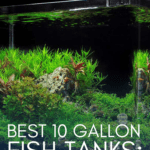Of all the fish tanks on the market, no other capacity is as popular as the humble 10-gallon aquarium. Novices often gravitate towards them for starter set-ups, while experienced keepers use them for quarantine, hospital and breeding tanks. Let’s talk about what you need to know to pick the best 10-gallon fish tank for your next project!
Quick Comparisons of the 5 Best 10-Gallon Fish Tanks
| IMAGE | BRAND | DETAILS | |
|---|---|---|---|
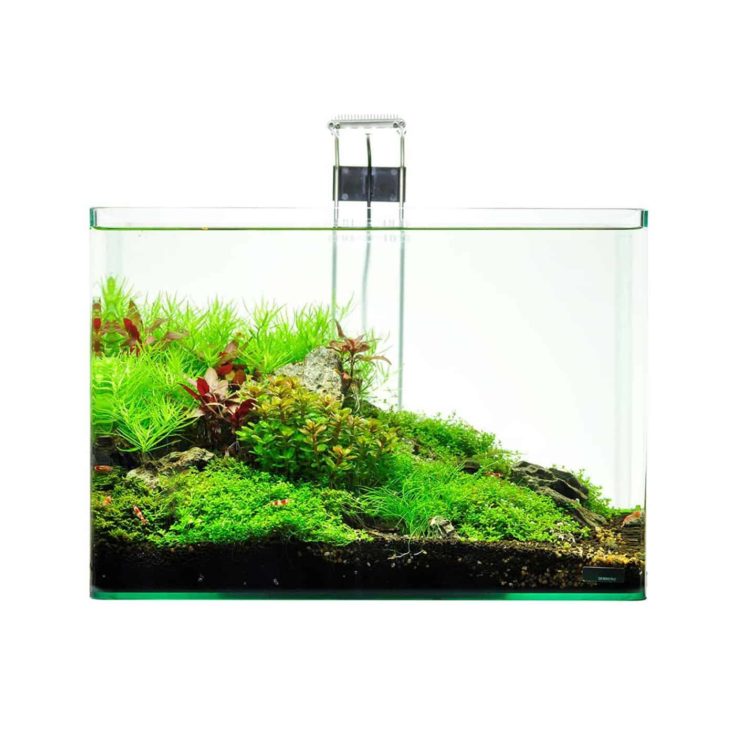 | Dennerle Scapers 10 Gallon Aquarium Kit with LED Light |
| View Product |
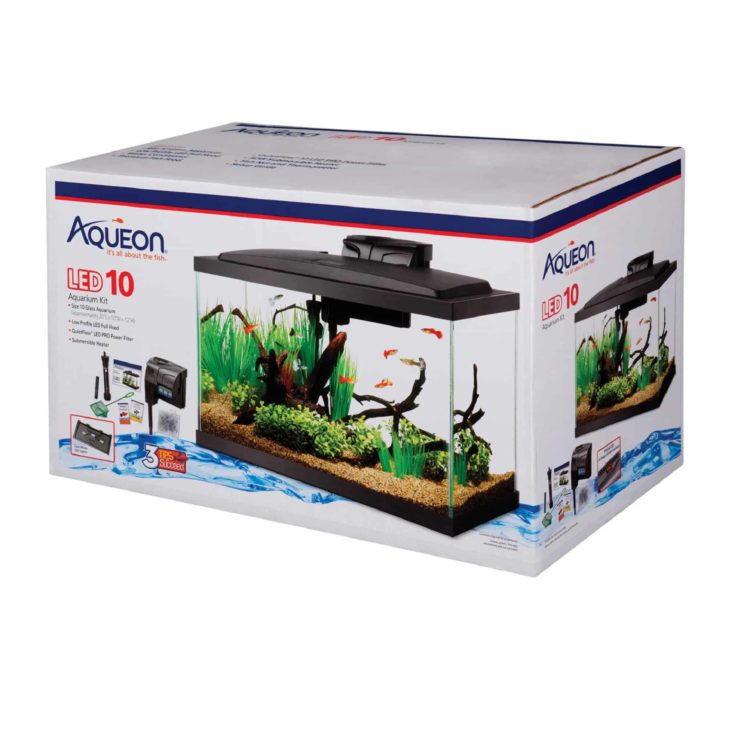 | Aqueon LED 10 Gallon Aquarium Kit |
| View Product |
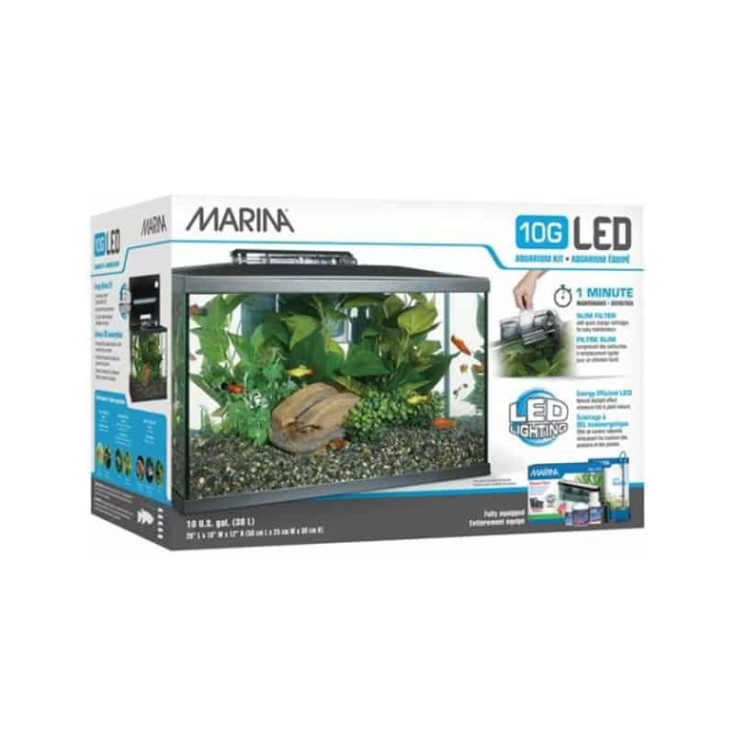 | Marina LED Aquarium Kit |
| View Product |
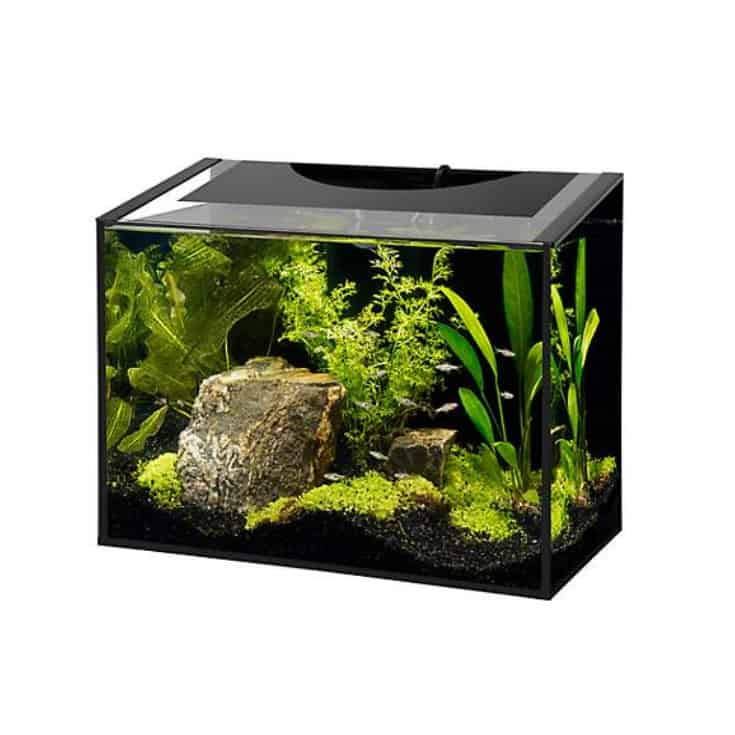 | Aqueon Ascent Frameless LED Aquarium Kit |
| View Product |
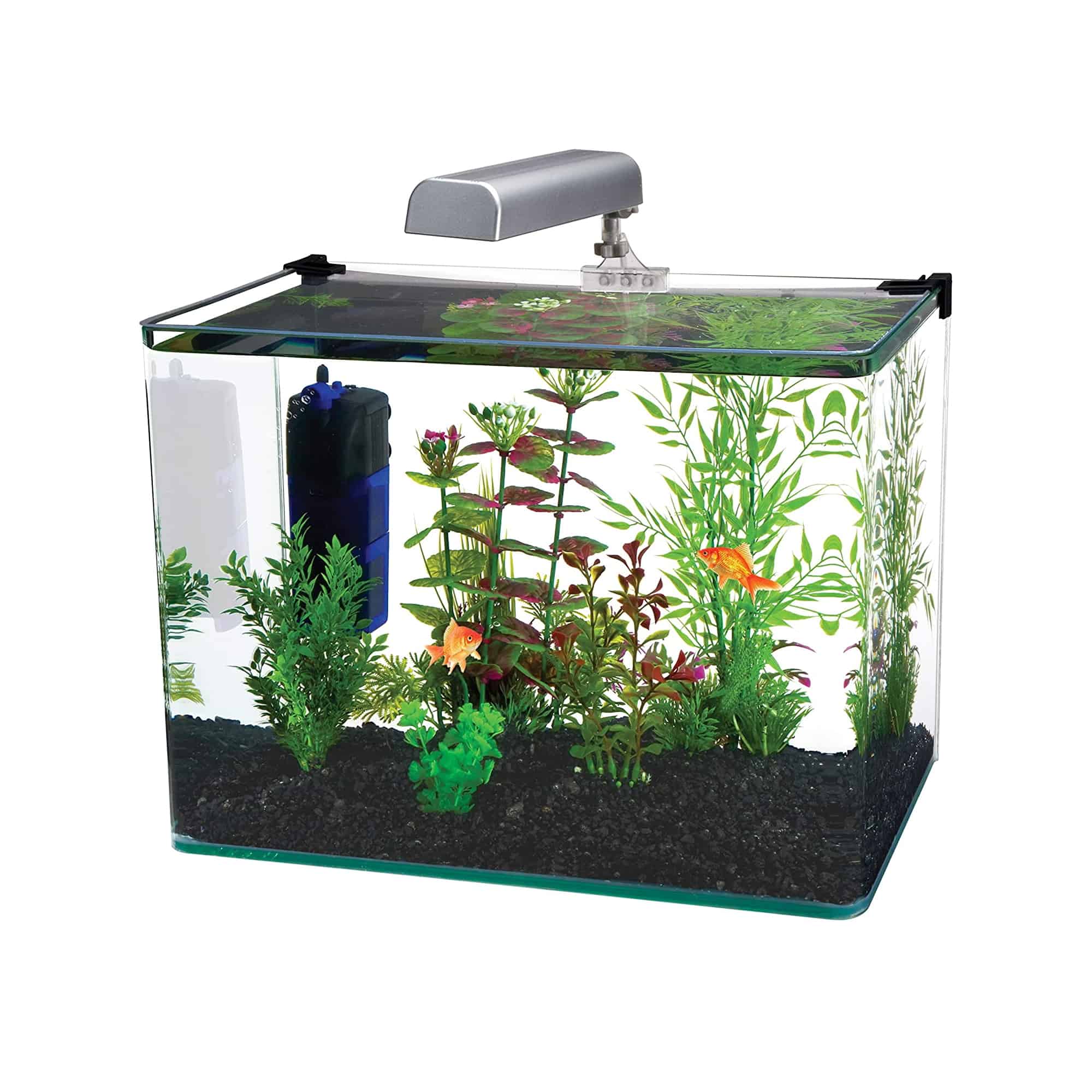 | Penn Plax Curved Corner Glass Aquarium Kit |
| View Product |
Buyer’s Guide for 10 Gallon Aquariums
Despite their popularity, there are not many online guides specifically covering 10-gallon aquariums. These useful tanks and their associated starter and speciality kits are often covered along with other nano tank set-ups, but only rarely get time in the spotlight. These tanks deserve better, so here’s a detailed buyer’s guide!
Benefits of 10 Gallon Aquarium Set-Ups
Why are 10-gallon fish tanks so popular? There’s a few reasons why they tend to be the size of choice for new fish keepers. Their convenience and practicality also means that most aquarists hold onto their 10-gallons even if they upgrade to a larger tank.
At one time, 10-gallons were the smallest capacity aquariums on the market. If you wanted a desktop set-up or a tank that didn’t require a special stand, you were either limited to a fish bowl or went with a 10-gallon. This led to their reputation as the best size for a starter tank, which lingers in the industry today.
10 gallon aquariums are an ideal option for many aquarists because:
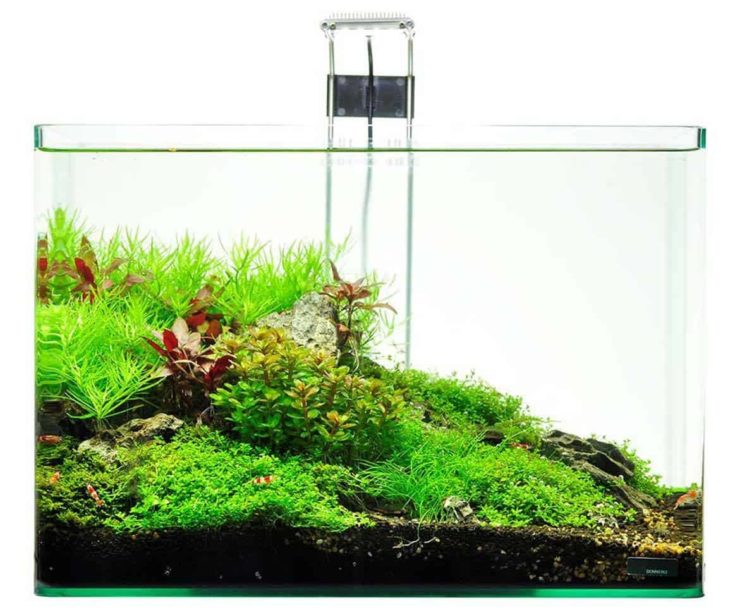
- They are flexible to use and are the perfect size tank for breeding, quarantine and hospital set-ups, as well as being a good option for starter tanks.
- They are large enough to hold several interesting nano fish or invertebrates.
- They don’t require the constant maintenance of a fish bowl or smaller nano tank as long as they are properly equipped.
- There are many budget and premium options for equipping 10-gallon tanks with filters, LED lights, heaters, decorations and live plants.
- You can easily customize your 10-gallon set-up just the way you prefer by picking out individual pieces of equipment.
- If your budget is tight, a 10-gallon starter kit could be an inexpensive way to get most of the supplies you need to start you tank.
- There’s enough room inside to design a stellar themed or planted 10-gallon tank.
- It’s an ideal size to start with if you have an interest in aquascaping.
- You can also opt for a bare-bottomed tank if you’d prefer a minimalist or modern appearance.
Disadvantages of 10 Gallon Aquariums

While 10 gallons is an ideal option for many purposes, being neither too small nor too large, that doesn’t mean they’re always the right tank for the job. While they make a good size for new aquarists to learn on, they can also be a little tricky. You’ll definitely need a sturdy table to set your tank on (see weight section below).
10’s are easier to maintain than smaller tanks, but not quite as easy as their larger cousins. As long as you have a robust filtration system and don’t overfill your tank with critters, you can likely get by with weekly water changes. But just as with other nano tanks, when things go wrong in a 10-gallon, they go wrong quickly.
While 10s make good options for novice aquarists or children’s tanks, in truth, a 20 or 30-gallon tank is a better size for a starter tank. They require less maintenance than 10s and don’t suffer as much from the sudden ammonia spikes that can crash a smaller tank in a matter of hours.
Advantages
- Most flexible and economical aquarium size.
- Ideal size and capacity for breeding, hospital and quarantine tanks.
- Good size for a first aquarium or starter tank.
- A large variety of inexpensive and premium filters, lights, heaters and other equipment.
- Easier to maintain than smaller nano tanks and much easier than fish bowls.
- Small enough to fit on sturdy desks and tables and doesn’t require a special aquarium stand.
Disadvantages
- Harder to maintain and requires more effort than a larger 20 or 30-gallon tank.
- More likely to crash from a sudden spike in ammonia or have an unexpected algae outbreak than larger tanks.
- Not easy to move once filled with water, and needs a sturdy and durable place to reside.
Features of 10 Gallon Aquariums
What can you expect to find when you’re researching your options for 10-gallon tanks? While the older, used tanks you’ll see at garage sales may appear nearly identical, these days there’s a lot more variety to choose from in a new tank.
How Much Does a Filled 10 Gallon Tank Weigh?
Before we wade in any further, let’s take a second to talk about weight. You’ll need to be sure the spot you’ve chosen for your tank can support its weight when filled with substrate, equipment and water. Since a gallon of water weighs 8.34 pounds, 10 gallons weigh about 83.4 pounds.
Depending on the construction materials, an empty 10-gallon weighs somewhere between 5 and 11 pounds. You’ll usually fill it with at least 10 pounds of substrate and possibly more if you’re raising live plants. Add in the equipment and decorations, and a filled 10-gallon usually falls in the 111 to 120 pound range, mostly due to the water.
Types and Dimensions of 10 Gallon Tanks
You’ll notice a bit of variation when you’re looking at the manufacturer specs and dimensions for various 10-gallon aquarium kits:
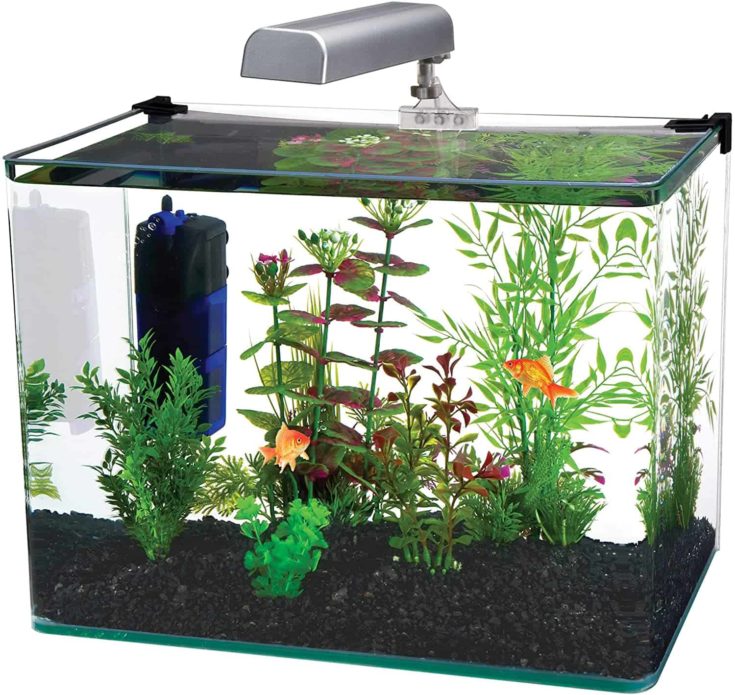
- There are two primary types of 10-gallon tanks, and many unique styles.
- While they all hold the same amount of water, their internal and external measurements vary depending on their specific shape and whether they have a frame, rim or elevated base.
- Equipment such as lids, hoods, lights and filtration systems may also add several inches to the overall dimensions of your complete set-up and/or the manufacturer’s spec sheet.
Standard 10 Gallon or Leader Tanks
The most common type of 10 is the standard size, which measures about 20 x 10 x 12 inches on the inside of the tank. This is also sometimes referred to as a “Leader tank,” and it’s the most popular type by far. These tanks usually have a plastic frame and rim, and some may also come with an elevated base.
The advantage of going with a standard-sized 10-gallon tank is it’s easy to find equipment and supplies designed to fit in or on it. You won’t have to limit yourself to a specific manufacturer or customize your equipment so it’ll work with your tank. I have supplies I bought 30 years ago that still fit in a new standard 10 gallon!
10 Gallon Tall and Portrait Style Tanks
I was surprised to see that 10-gallon tall aquariums are not easy to find anymore, although there are a lot of portrait style options in the smaller sized nano tanks. A classic 10-gallon tall tank measures about 16 x 8 x 17 inches on the inside and is taller and narrower than the standard.
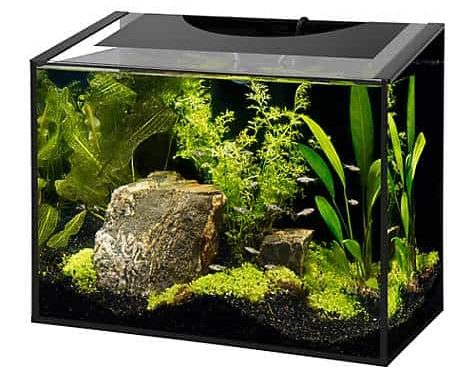
Portraits are a great shape to go with if you’d like to aquascape your 10-gallon tank, but they aren’t ideal for fish-only set-ups. The narrower base and vertical orientation means they provide less room for swimming. These could be a good choice for shrimp tanks, although you’ll be more limited in terms of the equipment that will fit.
Styles of 10 Gallon Tanks
Of course, plenty of unique and custom 10-gallons are around, and these come in a wide variety of shapes and styles. Some tanks are lower and wider than the standard to provide more room for swimming, while others may have curved or rounded front panels or corners.
Each style of tank has its own advantages and disadvantages, and some are harder than others to find equipment for. Some of the styles you’ll see in 10-gallon tanks include:
- Bow front or curved front tanks have rounded front panels which magnify and enhance the appearance inside.
- Low profile tanks are shorter and wider and help minimize or hide the appearance of the water line.
- Curved or molded corner tanks are often constructed from fewer pieces for added strength and make it easier to see inside when sitting at an angle.
- Some tanks have their front or rear panels angled instead of attached squarely to the base, which increases the view inside and minimizes the appearance of the water line.
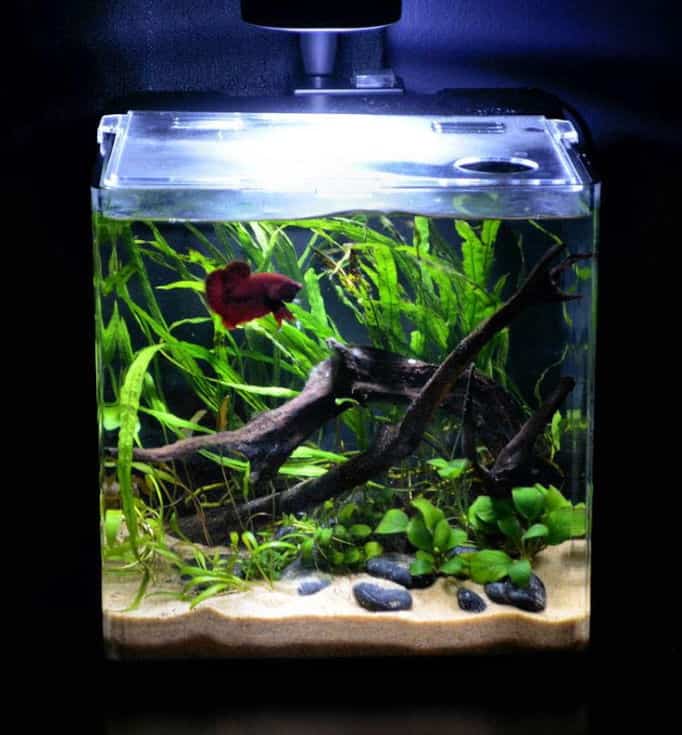
- Rimless tanks ditch the extra framing to create a very streamlined and modern appearance where all you see are the tank’s occupants. They are more delicate and easily broken, harder to find equipment for and can cause injuries from the exposed sharp edges.
Setting up Your 10 Gallon Tank
Let’s talk about how to set up a 10-gallon freshwater fish tank. First, double check that the desk, shelf or table you’ve chosen to place it on can handle the weight and is near an electrical outlet. To provide a bigger margin of safety, I aim to use furniture that can support at least 150 pounds for my 10-gallon aquariums.
Unbox your tank and equipment, remove any labels and rinse everything clean. Place a rubber mat under your tank to protect the surface. Rinse your substrate well, or if it comes packaged in special water just add it straight to your tank. Set up your filters, heater and light and fill the tank with conditioned water.
Turn your equipment on, adjust the filter and thermostat but leave the lights off while you cycle the tank for a few weeks to prevent algae outbreaks. Once your tank’s nitrogen cycle has stabilized, you can turn the lights on and start adding fish to your new tank!
How to Choose Your 10 Gallon Fish Tank
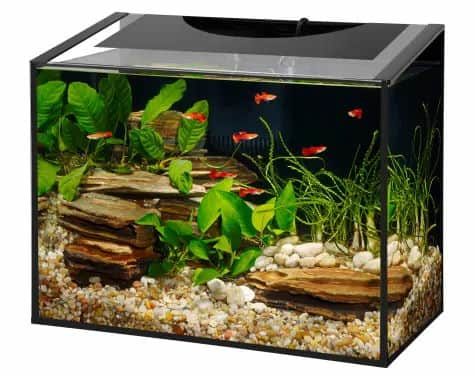
You may already have a good idea of the type and style of 10-gallon you’d like to get after reading the sections above. If you’re still not sure, here are some additional pointers for choosing the perfect tank!
Construction Quality and Materials
It’s not always easy to identify a high-quality tank from a marginal one when looking at pictures and descriptions online. In person, I always examine the tank’s frame, seams and seals. If the sealant is sloppy or unevenly applied I avoid buying the tank. 10 gallons of water can cause a lot of damage if it springs a sudden leak!
Glass tanks are considered the standard, and while they have disadvantages they are still my preference for 10-gallon aquariums. Acrylic tanks are made from a high-quality type of plastic that is lighter and more flexible than glass, but also more expensive. Plastic tanks are the cheapest and the least durable of the three.
Here’s how the different tank materials stack up against each other:
Tank Material
Glass
Advantages
- Inexpensive and can be used and reused for years
- Less likely to develop scratches over time
- Won’t absorb or release chemicals in the water (although the silicone sealant may)
- Won’t turn yellow or become discolored with exposure to sunlight
- Minimal distortion effect when looking into the tank
Disadvantages
- Heaviest construction material
- Limited number of custom shapes
- Can crack or shatter if something hits it the wrong way
- May have sharp corners or edges that could cause injury
Tank Material
Acrylic
Advantages
- Lightweight but sturdy
- Easy to find in cornerless, rimless and custom shapes
- Corners and edges are rounded and less likely to cause injury
Disadvantages
- Maybe more expensive than other types
- Easily scratched, dinged and cosmetically damaged
- More noticeable distortion when looking into the tank
- May absorb and release chemicals
- Turns yellow when exposed to sunlight and over time
Tank Material
Plastic
Advantages
- Cheapest material
- Lightweight
- Can be molded into many different shapes, including bow front and cornerless tanks
Disadvantages
- Scratches easily and can crack with too much pressure
- Noticeable distortion effect when looking through the side
- Turns yellow with age and exposure to light
- Can soften when exposed to higher temperatures and may not be suitable for some types of equipment
Stocking a 10 Gallon Tank with Fish and Invertebrates
What are some good fish for a 10-gallon tank? While these tanks are too small for goldfish, they are the perfect size for nano fish. The general rule of thumb is to allow a gallon of water for every inch of fish in the tank, but more room is always better. Consider stocking with some easy beginner’s options such as:
- Male Betta fish or a pair of female Bettas
- Small rasboras like the Harlequin or Chili
- Neon, Cardinal and Ember tetras
- Livebearers like guppies, mollies, platies, and swordtails
- Dwarf crayfish
- African Dwarf Frogs
- Amano, Cherry or Ghost shrimp
- Snails like Mystery, Nerite, and Malaysian Trumpet
Overall Price: Should You Get a 10 Gallon Starter Kit?
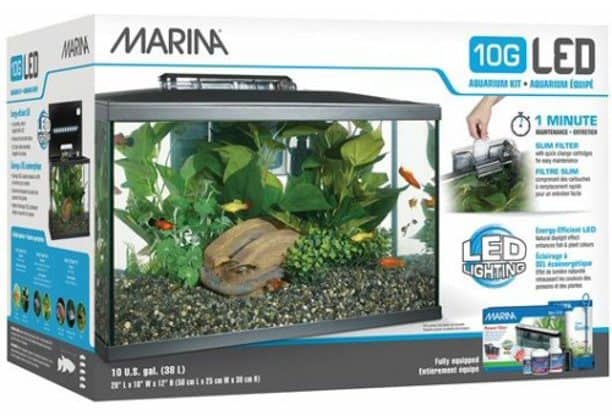
Finally, let’s talk about buying a kit or whether you should grab your equipment separately. If you’ve never maintained an aquarium before, it may be less expensive to buy a kit that includes a lot of the supplies you’ll need. Then you can purchase what’s missing and save a few bucks.
The cheapest way to start an aquarium is to find a used tank and equipment that’s still in good shape. But this doesn’t give you as many options as buying a kit or individual items. If you already have a few supplies, though, it may make more sense to avoid kits and buy exactly what you need instead.
10 Gallon Aquarium Kits: Starter Tank Product Reviews
It’s time to take a look at some of the best 10-gallon specialty and starter kits on the market and see if one of these set-ups is ideal for your needs. You’ll notice that I didn’t include acrylic or 10-gallon plastic fish tanks in the reviews. In terms of quality and price, these kits were superior and there’s a lot more options for glass tanks too.
1. Dennerle Scapers 10 Gallon Aquarium Kit with LED Light

- Tank Type: Low Profile Glass
- Dimensions: 17.8 x 12.2 x 14.2
- Kit includes: Tank, clear cover, LED light, internal biofilter, under-tank mat
If you’re interested in a plant-focused tank, then this 10-gallon aquascape kit from Dennerle might be the one for you. The seamless front panel with rounded corners and low profile allows a fully unobstructed view into your tank. This kit includes a simple biological filter and LED light perfect for raising plants and a few fish.
| PROS | CONS |
|---|---|
|
|
2. Aqueon LED 10 Gallon Aquarium Kit

- Tank Type: Standard Glass
- Dimensions: 20.25 x 10.5 x 13.3
- Kit includes: Tank, plastic hood with LED light, QuietPro HOB filter, preset heater, fish supplies and a care guide
If you’ve never owned a tank before, then this inclusive kit from Aqueon could be the best and least expensive way to start a tropical aquarium. It even includes a heater, although the quality is dubious. You’ll get the basic supplies you need to set up your tank, and at less than $100 you’ll have money leftover for gravel, decorations and fish!
| PROS | CONS |
|---|---|
|
|
3. Marina LED Aquarium Kit

- Tank Type: Standard Glass
- Dimensions: 20 x 10 x 12.5
- Kit includes: Tank, plastic hood with LED light, Marina Slim Clip-on Filter, Fish supplies and a care guide
This starter kit from Marina includes a high-quality standard tank and is a little more compact than the Aqueon, since it uses a clip-on 2-stage filter instead of a classic HOB. You can tuck this tank right against a wall or shelf. The LED light is integrated into the plastic hood. It also comes with some water conditioner, fish food, a fish net and an aquarium guide.
| PROS | CONS |
|---|---|
|
|
4. Aqueon Ascent Frameless LED Aquarium Kit

- Tank Type: Frameless Angled Glass
- Dimensions: 18.75 x 10 x 15.75
- Kit includes: Tank, glass canopy with LED light, internal filter, fish supplies
If you’d like a fish tank that looks fresh and modern in design, this frameless glass tank from Aqueon might be a good option for your home or office. It’s not the most durable design, but the angled panels allow for a beautiful view inside. The glass canopy and LED are practically invisible, and the internal filter fits in a corner of your tank.
| PROS | CONS |
|---|---|
|
|
5. Penn Plax Curved Corner Glass Aquarium Kit

- Tank Type: Curved Corner Glass
- Dimensions: 12.625 x 11.75 x 17.75 inches
- Kit includes: Tank, hinged plastic lid, clip-on LED light, internal filter, under-tank mat
If you’re looking for something a bit different, this frameless and seamless glass tank from Penn Plax could be the kit for you. The curved corners make it easy to see into this tank from any direction, and it comes with some basic equipment like an LED light and internal filter. It’s a lovely tank, but I’m less impressed with the whole kit and would upgrade most of the equipment.
| PROS | CONS |
|---|---|
|
|
Conclusion
As you can see, it never hurts to pick up an extra 10-gallon tank even if you’re not using one as your primary aquarium. They are popular with beginners, and while a 20 or 30-gallon is easier to maintain it can be a lot less expensive to start with a 10. Especially if you buy a starter kit that includes other useful equipment!
Tell us about your 10-gallon tank in the comments, or follow us online. If you’re still not sure which kit on my list is best for you:
- I really like the Dennerle, and if aquascaping is in your plans this could be the best tank to start with.
- For standard 10-gallon starter kits, both the Aqueon or Marina come with the basic equipment and supplies, although the Marina is higher quality and a bit more expensive to boot.
- If you want a rimless or seamless tank, either the Aqueon Ascent or the Penn Plax could be the pick for your home, depending on which style you prefer.
